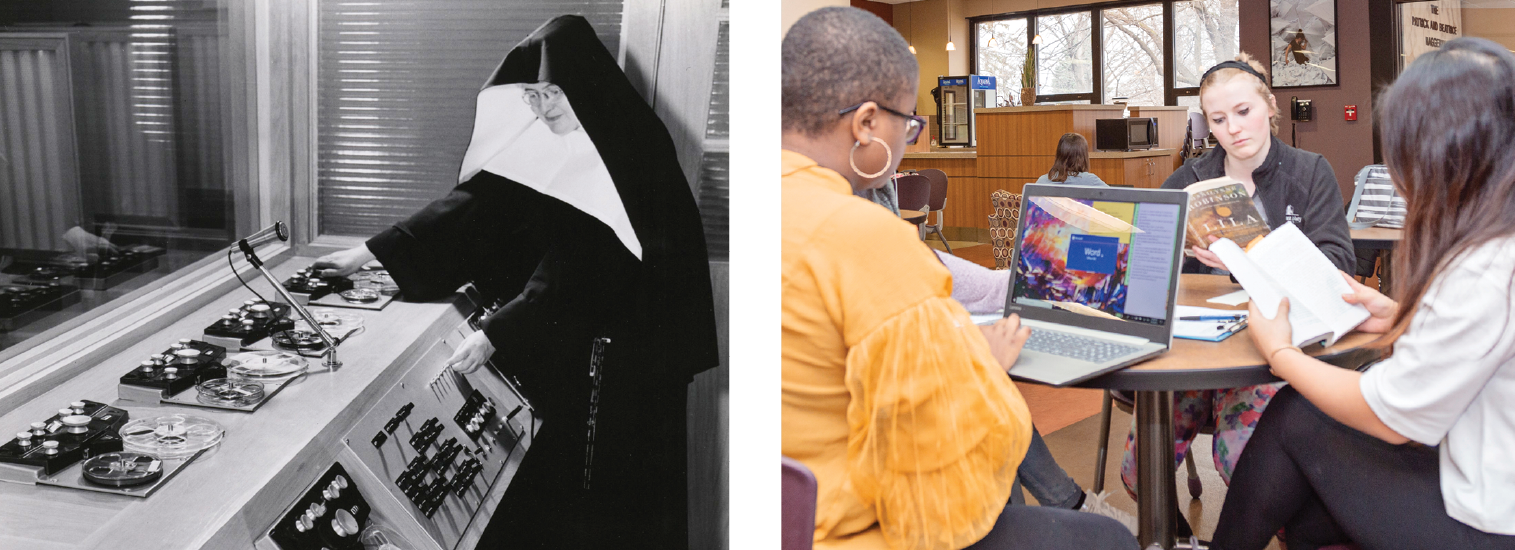Then & Now: Campus has always tapped into technology to learn languages

Posted on April 23, 2020
In 1958, a new language lab was installed on the Mount Mary campus, and the process of learning a world language was transformed.
Previously located beneath the theater lobby in Kostka Hall, the lab featured a control room, a 500+ tape-disc library and 21 private booths with individual audio channels. It was state-of-the-art technology at the time that enabled professors to send out six different lessons, across French, Spanish and German, simultaneously. Students could also learn by watching movies on the projector screen in the front of the lab from their glass-enclosed booths. The language lab even featured soundproof recording studios, enabling the students and professors to record their own tapes.
The language lab was used for over four decades. And then in the 1990s a new technology arrived — the internet.
The internet has provided unlimited access to a variety of language-learning tools, and Spanish professors Mary Ellen Kohn-Buday, Ph.D, and Jason Meyler, Ph.D, are using this new technology in creative and innovative ways. Both professors use a range of websites and videos, including TED-style talks, podcasts and films, to help their students take learning beyond the book, their classroom and most often, the country. Students have even been tasked with recording their own videos and uploading them online, where they can practice speaking Spanish and learn from one another.
As the Latinx population continues to grow on Mount Mary’s campus, at least half of the students in Meyler’s and Kohn-Buday’s Spanish classes are heritage speakers. There is a mutual learning that takes place in the classroom between bilingual and second-language learners, and the Internet aids in that learning.
“The bilingual students mentor non-heritage speakers while practicing how to be articulate and clear.” says Kohn-Buday. “All students learn that every individual has a different way of speaking.”
Studying the dialects across the 22 Spanish-speaking countries worldwide is even easier today and is a priority in every Spanish class. Students create a variety of projects on their global research, from PowerPoint presentations to mock infomercials. In the process, bilingual students have found a deepened sense of pride in their heritage as they share with the class, where speaking their first language is encouraged and welcomed.
Modern students now have unparalleled access to the past thanks to the internet. Students can study historical texts in depth online, frame by frame, such as Aztec codices, dating as far back as the early 1500s. These manuscripts were typically made from natural materials that mostly consist of images, and students recreate their own versions of these historical texts to deepen their study of the history of the Spanish language further.
Looking ahead, both Kohn-Buday and Meyler expect several of their Spanish courses will be taught in a hybrid method, featuring a blend of online and in-person classes.
“Technology is never-ending, and we are able to incorporate the best of what’s available to us,” Meyler says.



